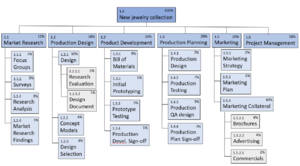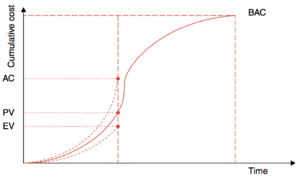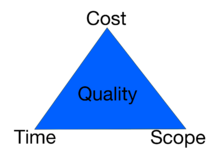Earned Value Analysis : A tool for decision-making
Developed by Søren Kaarsholm
The Earned Value Analysis (EVA) Is a method used in Project Managment for monitoring the performance and progress of a project through a comparison of the planned project and the actual project. Measurements of the three components of the Project management triangle, Time, Cost & Scope are used as inputs in the analysis to create an objective estimate of the project's health. The purpose of EVA is to enable the project manager to make informed decisions based on objective results that are directly derived from the project's main performance indicators Time, Cost & Scope.
Contents |
History
The Earned Value Analysis, initially named PERT/COST was first used by the US government in the 1960s as the tool was imposed onto the contractors of the US Department Of Defense as a way of standardising the performance tracking of all the departments different projects. PERT/COST generated a large discontent amongst the contractors due to its inefficiency and was ultimately changed by the US Department Of Defense in the late 1960s. From this a new analysis arose called Cost/Schedule Control Systems Criteria (C/SCSC) which is the criterion based approach that is now used widely through all of project management and known as the Earned Value Analysis (EVA) which further led to the practice of Earned Value Management (EVM) [1]
Overview
EVA is a dynamic project management tool that allows a project manager to measure or forecast the performance of a project at any given time throughout the lifetime of a project. its use of quantitative performance indicators makes it an objective tool which can be utilised in any scenario. The tool EVA is the fundamental element in the so called Earned Value Management (EVM) which is a management methodology in which a project is administered through decisions based on the results of the EVA. The methodology is widely used in the industry because of its ability to facilitate informed objective decision making and it's flexibility stemming from the time related inputs and outputs.
Depending on the size and complexity of the project the EVA might need different features in order to produce an adequate analysis of the project.
To perform a basic Earned Value Analysis the following features are required :
Adequate measurements from the following project indicators must be available.
- Time
- Cost
- Scope
Prerequisites for EVA
- A project plan, containing all the tasks of the project along with the time schedule (eg. Gantt chart )
- An estimate of the cost of each task within the project plan also known as "budgeted cost of work scheduled" (BCWS) or "Planned value (PV)
- An overview of the "Budgeted Cost Of Work Performed"(BCWP) or "Earned Value" (EV)
Terms & Definitions
When performing an EVA the following terms and definitions must be familiarised. In more specific cases eg. "EVA in Human Resource Management" more terms and definitions will be necessary to obtain the desired results. Therefore the following terms and definitions are the most commonly used ones.
| Name | Definition | Equation |
|---|---|---|
| Time of Review (TR) | The point in the total lifetime of the project at which the analysis is performed | |
| Budgeted Cost of Work Scheduled (BCWS) | The budgeted cost that is assigned at each task or as a cumulative value up until the Time of Review. (Also known as Planned Value (PV)) | |
| Budgeted Cost of Work Performed (BCWP) | The value that is earned from each of the tasks in the project or as a cumulative value up until the Time of Review. (Also known as Earned Value (EV) ) | |
| Actual Cost of Work Performed (ACWP) | The actual cost of each task in the project or as a cumulative value up until the Time of Review. ( Also known as Actual Value (AV) ) | |
| Cost Variance (CV) | The variance between the Earned Value and the Actual Cost of a task in the project plan. A positiv value of the Cost Variance suggest a favourable impact on the project, and visa versa, a negative Cost Variance suggests an unfavourable impact. | ( CV = EV - AV )
or ( CV = BCWP - ACWP ) |
| Cost Performance Index (CPI) | The percentage of Earned Value over the Actual Cost. | ( CPI = EV / AV )
or ( CPI = BCWP / ACWP ) |
| Budget at completion (BAC) | The total budget of the project at the end of its lifetime. | |
| Scheduled Variance (SV) | The variance between the Earned Value and the Planned Value of a task in the project plan. A positiv value of the Scheduled Variance suggest a favourable impact on the project, and visa versa, a negative Scheduled Variance suggests an unfavourable impact. | ( SV = EV - PV )
or ( SV = BCWP - BCWS ) |
| Schedule Performance Index (SPI) | The percentage of Earned Value over the Planned Value. | ( CPI = EV / PV )
or ( CPI = BCWP / BCWS )[2] |
| Critical Ratio (CR) | The product of CPI and SPI which is the final performance indicator for the project. A positiv Critical Ratio suggest a favourable impact on the project, and visa versa, a negative Critical Ratio suggests an unfavourable impact. | (CR = CPI  SPI) SPI)
|
| Cost estimate at completion (CEAC) | The estimated cost of the entire project at the completion date. This value is derived from the Budget of the project. | CEAC = AC + (BAC-EV) / CPI |
Table 1: Common Terms & Definitions in EVA
Application


To apply the EVA firstly the BCWP & BCWS of the project must be obtained from the projects Work Breakdown Structure (WBS). The values are considered according to the Time of Review. If the Time of Review is not in the initial phase of the project, the ACWP should also be available and from that the CPI and SPI of the project can be calculated. This finally leads to the CR which will then determine the health of the project. If the EVA is performed and its results are tracked as the project goes on, the trend of the different performance indicators can be determined and from this a valid forecast of the projects performance can be carried out.
Forecasting
The results of the EVA are not only indicators of the current state of a project, but they can also be used for forecasting the future state of a project. This is done through the Cost Estimate at Completion (CEAC) [4] The forecast is done using the Actual Cost (AC) at the Time of Review (TR) and adding the Budget at Completion (BAC) with the Earned Value (EV) at (TR) subtracted, and then divided by the Cost Performance Index (CPI) at (TR)

This makes a prediction of the cost of the entire project at completion. It should be noted that it is the CPI that rules whether or not the forecast has a negative or a positive development.
Other forecast are available through the EVA such as time schedule forecasts [5] and Work Remaining Forecast.
Decision-making
The general practice of decision-making in EVM. Where the EVA is the tool that facilitates the project manager with the ability to make informed and objective decisions, is carried out as following. [6]
If a project is managed using EVM with the results from the EVA being used as a benchmark for the different parts of the project. The Project manager is able to evaluate every part of an entire project and determine its impact on the project as a whole. This gives the project manager a unique ability to identify all the elements of the project that contribute to a decrease in the CR. The identified elements could then be reevaluated with regards to main performance indicators of the project : Cost, Time, and Scope. A decision could then be made on whether to scrap, alter, or keep the identified underperforming element.
If EVM is implemented properly into a business and the results of the EVA are available to all the employees. The responsibility and practice of EVM can be spread out from the project manager to the entire organization. Making each and every employee responsible for healthy EVA performance indicators within their areas of responsibility. In this way the EVM decision-making process is carried out continuously by the entire organization. This is a favourable practice since the "analysis" of each segment of the EVA will be carried out with much higher precious and knowledge, than if it was only a singular project manager or a team of managers doing the decision-making. [6]
Limitations
When using a tool like the Earned Value Analysis it is important to be aware of its limitations. If a project is controlled using EVM many of the decision carried in the project will be made based on the results of the EVA. This means a wrong estimate of a cost or a prolonged project could be the tipping point between option A and B in a decision process. Which could ultimately lead to wrong decisions being made over the right decision. The uncertainty of data is therefore the biggest limitation of EVA [7]. It can also be concluded that as the project goes on, this limitation decreases as the unknown-unknowns of the project becomes fewer and the overall uncertainty of the the project decreases, Therefore this limitation is more relevant in the initial phase of a project.
Another limitation of the EVA are all the other factors that influence the project that can not be implemented into the Analysis. Country specific rules [8] and regulations, Euro codes etc. These are all factors that can overrule a project optimisation decision proposed by the EVA. This means the EVA is restricted to what ever rules are imposed onto the project.
The organisational structure of the project and the different commitments through contracts could also be a limitation to the EVA being used as a decision making tool. Although an EVA could analyse a project and identifying the underperforming elements, they might not be subject to change since they are bond to the project by a contract. This could be an employee who is underperforming, or a subcontractor who is no longer needed. In this case the EVA is reduced from a decision making tool to a problem identification tool.
The forecasting aspect of EVA obviously has its limitation due to the nature of the work performed. A forecast will always be a guess, no matter how accurate previous results have been a forecast can never be 100% certain. And that it self is a limitation to the practice of decision-making based on the results of an EVA Forecast. The uncertainty of the forecast will directly equal a risk for the project.
Bibliography
Siew, Kwek Keong (2007). "Project performance measurement through earned value management methodology" This Article supplies a very good introduction the the concept of Earned Value Management and the Earned Value Analysis. The article also talks about the historical background of the methodology and it was developed through the 1960's up to the thing we know today as EVM and EVA. The article is a little old but seeing that it brings up both historical facts and a good introduction to the topic, the article still seams relevant today.
Baldwin, Andrew & Bordoli, David (2014-04-16). "A Handbook for Construction Planning and Scheduling" Chapter six of this book outlines the basic principles of the Earned Value Analysis and its different purposes and functions. The chapter also covers what is needed for a project manager to successfully carry out an EVA and use its results. The chapter uses very clear illustrations and graphs to convey the topic. The book is written in 2014 so it can almost be considered state of the art material on the topic.
M Vanhoucke & S Vandevoorde (2006). "A simulation and evaluation of earned value metrics to forecast the project duration" This Paper evaluates the methods used in EVA for forecasting the Total Project Duration. The paper is very organised and used all the common EVA abbreviations such as EV and CPI. The papir has its focus on the aspect of Time, rather than the aspect of Cost which is an equally important element in the EVA and in project management in general.
Fleming, Quentin W & Koppelman, Joel M (2016-12-20). "Earned Value - Project Management : Fourth Edition" The Book is a state of the art work on how Earned Value Management in carried out in a business, and what value it adds to the people working in this business. The initial chapters covers different aspects of how the EVA can be used as a decision-making tool in a business. Not only for a project manager but for the individual employee.
Alleman, Glen (2012-06-02). "Herding Cats : Issues with Deploying Earned Value Management Glen Alleman's Herding Cats, discusses the different issues and problems that are connected to successful deployment of Earned Value Management in a project. Through the writers personal experience, a lot of the common problemstatement of EVM & EVA are challenged, and he brings up a whole new set of problemstatements that seam to cover the topic more accurately. Although Glen Allemans problemstatements are from 2012 they are still relevant and will probably remain so.
Energi Styrelsen (2013). "DS/EN 1990 DK NA:2013 - Eurocode 0 : Projection of load bearing constructions The eurocode in mention is what is also known as a national annex, which can be seen a country specific rule or regulation. A foreign project manager would have to familiarise himself with this Eurocode before starting any projects in the given country, in order to construct a legal building. The national annexes are somewhat counter intuitive to the idea of the Eurocode, since the idea of them is to standardise all laws and legislation through out the european region. Therefore these annexes are important.
See also
Integrated Cost and Schedule Control
References
- ↑ Siew, Kwek Keong (2007). "Project performance measurement through earned value management methodology". Retrieved June 22, 2017
- ↑ 2.0 2.1 Baldwin, Andrew & Bordoli, David (2014-04-16). "A Handbook for Construction Planning and Scheduling". Retrieved June 12, 2017
- ↑ "http://CriticalTools.com". Retrieved June 21, 2017
- ↑ "Earned Value Management, Forecasting and TCPI (2012)" https://pmstudycircle.com/2012/05/fast-forward-earned-value-management-evm-forecasting-tcpi/. Retrieved June 22, 2017
- ↑ M Vanhoucke & S Vandevoorde (2006). "A simulation and evaluation of earned value metrics to forecast the project duration". Retrieved June 22, 2017
- ↑ 6.0 6.1 Fleming, Quentin W & Koppelman, Joel M (2016-12-20). "Earned Value - Project Management : Fourth Edition". Retrieved June 12, 2017
- ↑ Alleman, Glen (2012-06-02). "Herding Cats : Issues with Deploying Earned Value Management". Retrieved June 12, 2017
- ↑ Energi Styrelsen (2013). "DS/EN 1990 DK NA:2013 - Eurocode 0 : Projection of load bearing constructions ". Retrieved June 22, 2017
Further reading
Baldwin, Andrew & Bordoli, David (2014-04-16). "A Handbook for Construction Planning and Scheduling" The remaining chapters of this book are still relevant to the topic. And would support the topic of EVA as a decision-making tool quite well.
EVM FACILITATION & TRAINING IMPROVES REAL-TIME DECISION-MAKING A Website that covers different aspects of EVM based real time decision-making
